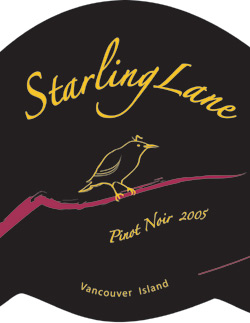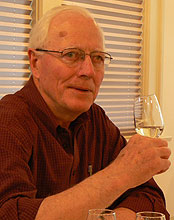

Starling Lane Winery
2005 Pinot Noir(Vancouver Island)
Pinot Noir ripens well in the relatively cool (compared with the Okanagan) growing season on Vancouver Island. The variety is one of the most widely planted. While some of the earlier vintages from various island wineries were rather light, more and more of the producers are releasing Pinots with substance. No doubt, that reflects increasing vine age and rising viticultural experience among the growers, all of whom have come from other backgrounds.
Starling Lane is a small winery near Victoria owned by three couples, each of which has grown grapes in its own two-acre vineyard for a decade or so. The Pinot Noir growers are John Wrinch, the winemaker, and a radiologist, and Ken Houston, a builder. Third partner Jerry Mussio is an educational consultant. Their wives also have professional backgrounds that complement their husbands in running the wine business. The Fleurie Vineyard, the third source of the Pinot Noir, is a Cowichan Valley property that sells to Starling Lane.
There is not much Pinot Noir among the three vineyards, for only 50 cases are being released. Dark garnet in colour, it has aromas of spice and cherries, following through with flavours of cherries, red currants and spice. There is enough tannin to give the wine a backbone and an aging potential (as if there is enough for serious cellaring!). The wine is bold, with good intensity of fruit flavours, with a finish that hints of spice and even chocolate. As tasty as the wine is now, it deserves to get a year or two in the cellar, giving it time to reveal even more complexity. 87 points.
Reviewed May 17, 2007 by John Schreiner.
Other reviewed wines from Starling Lane Winery
The Wine
Winery: Starling Lane Winery |
The Reviewer John Schreiner
John Schreiner
John Schreiner has been covering the wines of British Columbia for the past 30 years and has written 10 books on the wines of Canada and BC. He has judged at major competitions and is currently a panel member for the Lieutenant Governor’s Awards of Excellence in Wine. Both as a judge and as a wine critic, he approaches each wine not to find fault, but to find excellence. That he now finds the latter more often than the former testifies to the dramatic improvement shown by BC winemaking in the past decade. |














